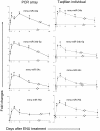Genomic analysis of microRNA time-course expression in liver of mice treated with genotoxic carcinogen N-ethyl-N-nitrosourea
- PMID: 21029445
- PMCID: PMC3091750
- DOI: 10.1186/1471-2164-11-609
Genomic analysis of microRNA time-course expression in liver of mice treated with genotoxic carcinogen N-ethyl-N-nitrosourea
Abstract
Background: Dysregulated expression of microRNAs (miRNAs) has been previously observed in human cancer tissues and shown promise in defining tumor status. However, there is little information as to if or when expression changes of miRNAs occur in normal tissues after carcinogen exposure.
Results: To explore the possible time-course changes of miRNA expression induced by a carcinogen, we treated mice with one dose of 120 mg/kg N-ethyl-N-nitrosourea (ENU), a model genotoxic carcinogen, and vehicle control. The miRNA expression profiles were assessed in the mouse livers in a time-course design. miRNAs were isolated from the livers at days 1, 3, 7, 15, 30 and 120 after the treatment and their expression was determined using a miRNA PCR Array. Principal component analysis of the miRNA expression profiles showed that miRNA expression at post-treatment days (PTDs) 7 and 15 were different from those at the other time points and the control. The number of differentially expressed miRNAs (DEMs) changed over time (3, 5, 14, 32, 5 and 5 at PTDs 1, 3, 7, 15, 30 and 120, respectively). The magnitude of the expression change varied with time with the highest changes at PTDs 7 or 15 for most of the DEMs. In silico functional analysis of the DEMs at PTDs 7 and 15 indicated that the major functions of these ENU-induced DEMs were associated with DNA damage, DNA repair, apoptosis and other processes related to carcinogenesis.
Conclusion: Our results showed that many miRNAs changed their expression to respond the exposure of the genotoxic carcinogen ENU and the number and magnitude of the changes were highest at PTDs 7 to 15. Thus, one to two weeks after the exposure is the best time for miRNA expression sampling.
Figures






Similar articles
-
Absence of mature microRNAs inactivates the response of gene expression to carcinogenesis induced by N-ethyl-N-nitrosourea in mouse liver.J Appl Toxicol. 2014 Dec;34(12):1409-17. doi: 10.1002/jat.2973. Epub 2014 Jan 30. J Appl Toxicol. 2014. PMID: 24478143
-
Increased expression of miR-34a in mouse spleen one day after exposure to N-ethyl-N-nitrosourea.J Appl Toxicol. 2011 Jul;31(5):496-8. doi: 10.1002/jat.1640. Epub 2011 Jan 25. J Appl Toxicol. 2011. PMID: 22297810
-
MicroRNA expression profiles distinguish the carcinogenic effects of riddelliine in rat liver.Mutagenesis. 2012 Jan;27(1):59-66. doi: 10.1093/mutage/ger060. Epub 2011 Oct 4. Mutagenesis. 2012. PMID: 21976715
-
The role of MicroRNA in chemical carcinogenesis.J Environ Sci Health C Environ Carcinog Ecotoxicol Rev. 2010 Apr;28(2):89-124. doi: 10.1080/10590501.2010.481477. J Environ Sci Health C Environ Carcinog Ecotoxicol Rev. 2010. PMID: 20552498 Review.
-
A review of the genotoxicity of 1-ethyl-1-nitrosourea.Mutat Res. 1993 Jul;297(1):3-38. doi: 10.1016/0165-1110(93)90005-8. Mutat Res. 1993. PMID: 7686271 Review.
Cited by
-
MicroRNAs in the DNA Damage/Repair Network and Cancer.Int J Genomics. 2014;2014:820248. doi: 10.1155/2014/820248. Epub 2014 Jan 30. Int J Genomics. 2014. PMID: 24616890 Free PMC article. Review.
-
Hepatic mRNA, microRNA, and miR-34a-target responses in mice after 28 days exposure to doses of benzo(a)pyrene that elicit DNA damage and mutation.Environ Mol Mutagen. 2012 Jan;53(1):10-21. doi: 10.1002/em.20668. Epub 2011 Oct 2. Environ Mol Mutagen. 2012. PMID: 21964900 Free PMC article.
-
The Prominent Role of HMGA Proteins in the Early Management of Gastrointestinal Cancers.Biomed Res Int. 2019 Oct 13;2019:2059516. doi: 10.1155/2019/2059516. eCollection 2019. Biomed Res Int. 2019. PMID: 31737655 Free PMC article. Review.
-
Identification of differential microRNA expression during tooth morphogenesis in the heterodont dentition of miniature pigs, SusScrofa.BMC Dev Biol. 2015 Dec 29;15:51. doi: 10.1186/s12861-015-0099-0. BMC Dev Biol. 2015. PMID: 26715101 Free PMC article.
-
Mechanistic roles of microRNAs in hepatocarcinogenesis: A study of thioacetamide with multiple doses and time-points of rats.Sci Rep. 2017 Jun 8;7(1):3054. doi: 10.1038/s41598-017-02798-7. Sci Rep. 2017. PMID: 28596526 Free PMC article.
References
Publication types
MeSH terms
Substances
LinkOut - more resources
Full Text Sources
Molecular Biology Databases

